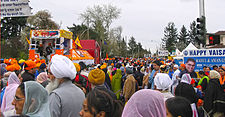
Vaisakhi
Background Information
SOS Children offer a complete download of this selection for schools for use on schools intranets. Child sponsorship helps children one by one http://www.sponsor-a-child.org.uk/.
|
ਵਸਾਖੀ |
|
|---|---|
 Vaisakhi parade in Surrey, British Columbia, Canada, on April 15, 2006 |
|
| Also called | Baisakhi |
| Observed by | Sikhs around the world. |
| Type | Religious |
| Significance | The birth of the Khalsa, the beginning of the harvest season. |
| Date | 1 Vaisakh ( April 13 or April 14 in the Gregorian calendar) |
| Celebrations | Parades |
| Observances | Prayers, Processions, raising of the Nishan Sahib flag |
Vaisakhi (Punjabi: ਵਸਾਖੀ, vaisākhī, also known as Baisakhi) is an ancient harvest festival in Punjab, which also marks beginning of a new solar year, and new harvest season. Vaisakhi also has religious significance for Sikhs. It falls on the first day of the Vaisakh month in the solar Nanakshahi calendar, which corresponds to April 13 or April 14 in the Gregorian calendar.
Vaisakhi is one of the most significant holidays in Sikh calendar, commemorating the establishment of the Khalsa in 1699. Vaisakhi is celebrated by the Khalsa as their birthday every year, the day corresponding to the event when they were created by Guru Gobind Singh in 1699.
This day is also observed as the beginning of the new year celebrated by the people of Nepal and Indians in West Bengal, Tamilnadu and Kerala and some other regions of India. The particular significance attached to the occasion shows regional variation outside of Punjab too. In Himachal Pradesh, Hindu Goddess Jwalamukhi is worshipped on Vaisakhi, while in Bihar, Sun-god Surya is honoured. The festival is celebrated as Rongali Bihu in Assam, Naba Barsha in Bengal, Puthandu in Tamil Nadu, Vishu (or Vaishakhi) in Kerala, and the Sinhalese/Tamil new year festival in Sri Lanka. Besides Punjab, Vaisakhi is widely celebrated as traditional harvest festival in many northern states of India, such as Haryana, Himachal Pradesh and Uttaranchal.
Celebrations
To mark the celebrations, devotees, irrespective of their religion, throng at gurdwaras, the Sikh place of worship. The celebrations start early as devotees, with flowers and offerings in their hands, proceed towards the gurdwaras and temples before dawn. Processions through towns are also common. Vaisakhi is the day on which the Khalsa (The Pure Ones) was born and Sikhs were given a clear identity and a code of conduct to live by. The event was led by the last living Guru, Guru Gobind Singh Ji, who baptised the first Sikhs using sweet nectar called Amrit. Around the world at Vaisakhi time, Sikhs and Punjabis reflect on the values taught to them by their Gurus and celebrate the birth of the Khalsa.
On top of this usually on this day in India, there is a huge parade/celebration. In the United States, there is usually a parade a few days after Vaisakhi, the actually day. In Manhattan, New York City there is a huge parade where many people come out to do seva (religious work) such as giving out free food, and completing any other labor needed to be done. The local Sikh community in Surrey, British Columbia, Canada holds its annual Vaisakhi celebrations in the April long weekend, which often includes a nagar kirtan, or parade, in which an estimated 200,000 people attend.
